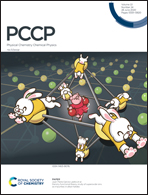Ion and water transport reasonably involves rotation and pseudorotation: measurement and modeling the temperature dependence of small-angle neutron scattering from aqueous SrI2†
Abstract
X-ray and neutron scattering have provided insight into the short range (<8 Å) structures of ionic solutions for over a century. For longer distances, single scattering bands have, however, been seen. For the non-hydrolyzing salt SrI2 in aqueous (D2O) solution, a structure sufficient to scatter slow neutrons has been seen to persist down to a concentration of 0.1 mol L−1 where the measured average spacing between scatterers is over 20 Å. Theoretical studies of such long distance solution structures are difficult, and these difficulties are discussed. The width of the distribution in distances between the scatterers (ions, ion pairs, etc.) remains less than 10 Å, which approximates the average size of the ions and their first hydration shell. Here, we measure the temperature dependence from 10 °C to 90 °C of the small angle neutron scattering (SANS) by a 0.5 molar SrI2 solution in D2O and find that this surprisingly narrow distribution of the distances remains constant within experimental uncertainty. This structure of the ions in the solution appears to endure because changes in interion distances along any single spatial dimension require displacements near the size of a water molecule. Together, the experimental measurements support a rotatory mechanism for simultaneous ion transport and water countertransport. Since rotation minimizes displacement of the solution framework, it is suggested that water transport alone also involves rotation of multimolecular structures, and that the interpretation of single-molecule water rotation is confounded by pseudorotation that results from paired picosecond proton exchanges. It is pointed out that NMR-determined millisecond to microsecond proton exchange times of chelated-metal-ion bound waters and the much faster chelate rotational correlation times around 10 picoseconds, both of which require making and breaking of hydrogen bonds, are difficult to impossible to reconcile.

- This article is part of the themed collection: 2020 PCCP HOT Articles


 Please wait while we load your content...
Please wait while we load your content...